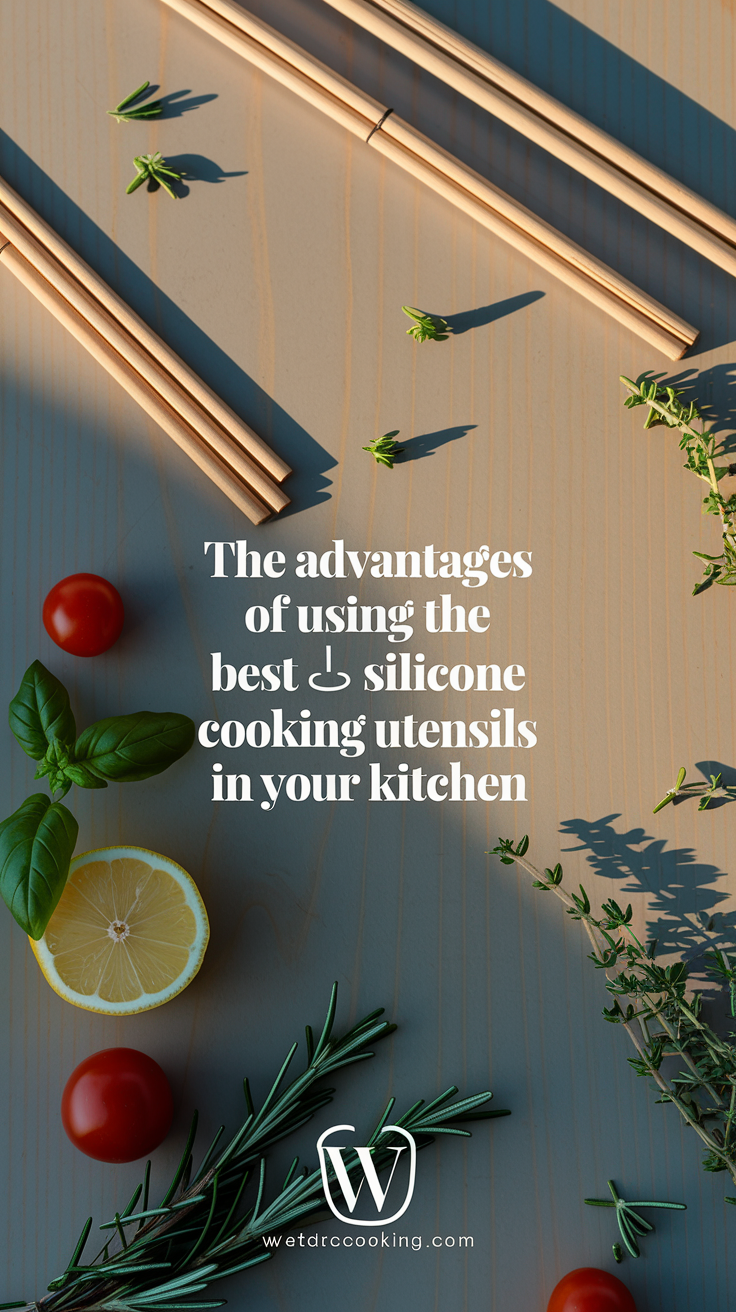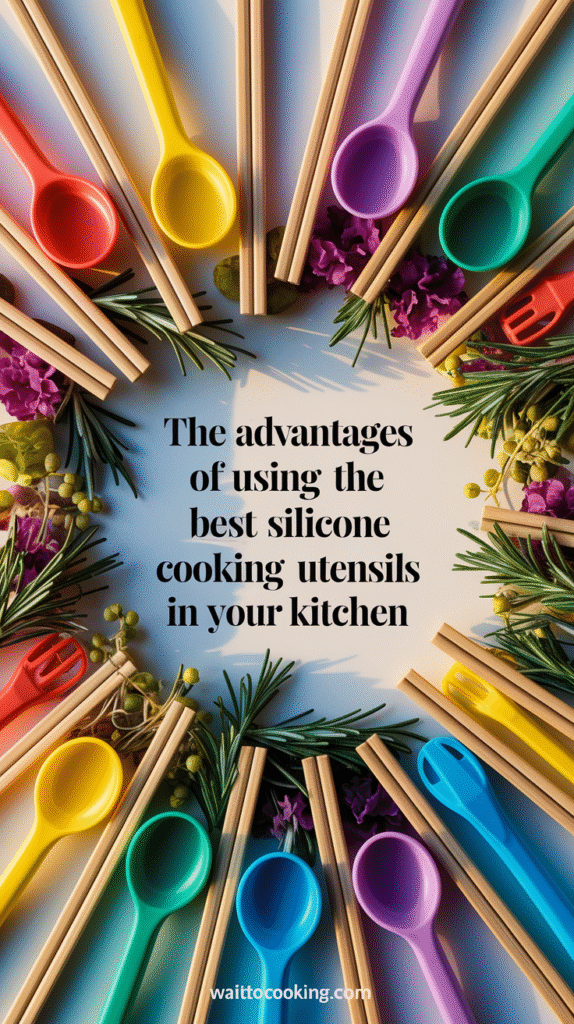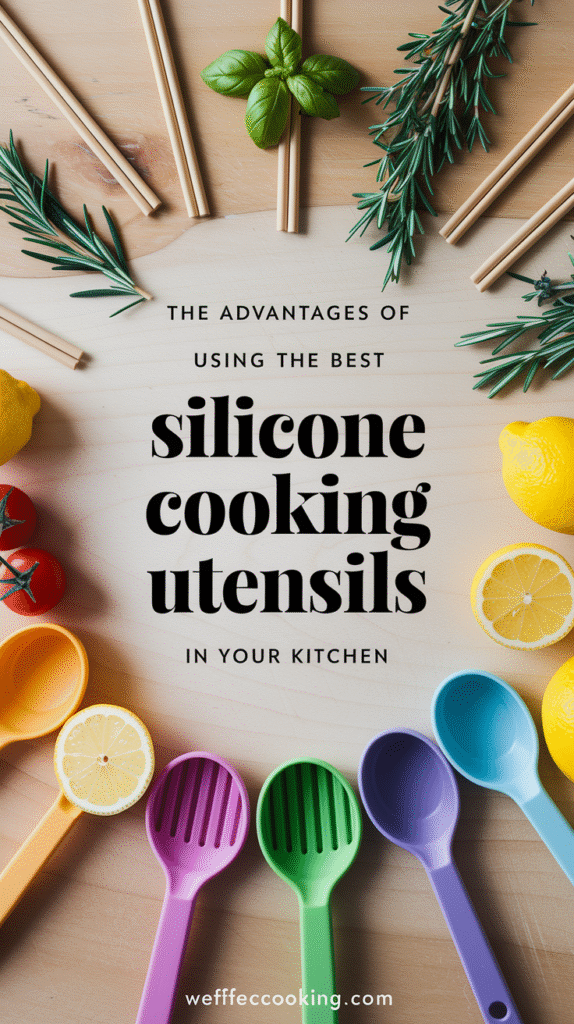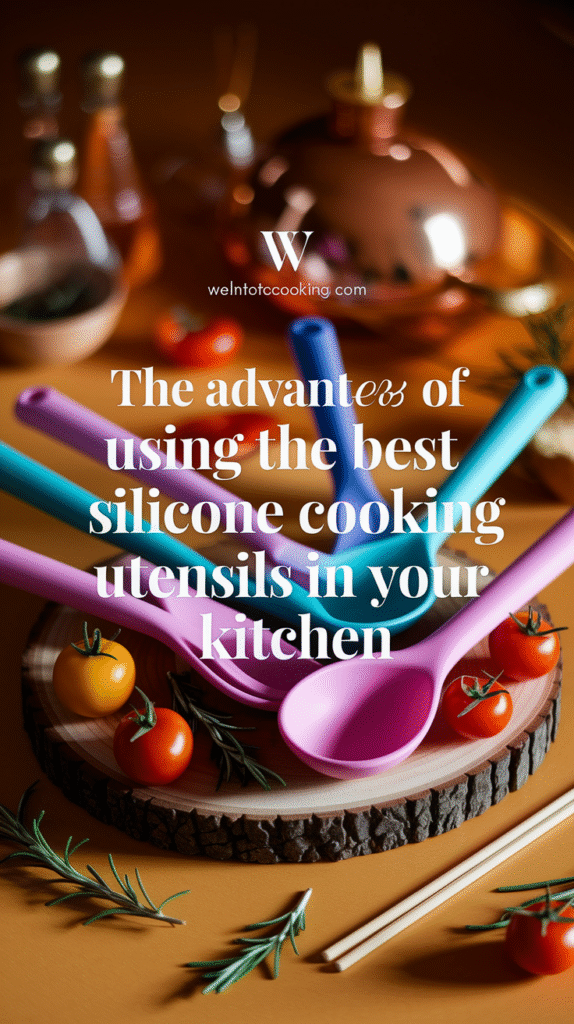When it comes to cooking, having the right tools can make all the difference. One essential in every kitchen is a good set of silicone cooking utensils. These utensils offer various benefits that enhance your cooking experience and help in maintaining the quality of your cookware.
Silicone cooking utensils are known for their heat resistance. Unlike plastic utensils that may melt or warp at high temperatures, silicone can usually withstand heat up to 500°F (260°C). This feature makes it an ideal companion for stir-frying and sautéing. You can confidently use silicone spatulas, spoons, and whisks directly in hot pans without fear of damage. This durability not only extends the life of your utensils but also protects your cookware.
Another significant advantage is that silicone is non-stick. This means that food won’t cling to your utensils, making cooking and clean-up much more manageable. You can easily scoop batter from a bowl or serve pasta without worrying about it sticking to your tools. This attribute also reduces the need for excessive oils or sprays, promoting healthier cooking methods.
Temperature safety is a critical factor in any cooking scenario. Silicone utensils remain cool to the touch, ensuring you won’t burn your fingers when stirring a hot pot or serving a dish. This safety feature is especially important for novice cooks or those with children in the kitchen.
Here are a few more benefits of silicone cooking utensils:
- Flexibility: Silicone is highly flexible, allowing you to scrape bowls and pots clean easily. They bend and flex to reach every corner, ensuring you utilize every bit of your ingredients.
- Easy to Clean: Most silicone utensils are dishwasher safe, making clean-up a breeze. They are also stain-resistant, which means they will look new for longer.
- Durability: Silicone utensils can last for years, even with daily use. Unlike wood, they won’t split or crack, and unlike rubber, they won’t wear out.
- Variety of Designs: Silicone cooking utensils come in various shapes and colors, adding a fun element to your kitchen decor. You can easily find sets that match your personality or kitchen theme.
Additionally, silicone utensils are safe for use on non-stick cookware. They won’t scratch or damage your pans, helping to extend the life of your expensive cookware. This compatibility means you can cook with peace of mind, knowing your investment in quality pots and pans is protected.
When searching for the best silicone cooking utensils, consider the following features:
- Quality of Material: Look for 100% food-grade silicone, which is BPA-free and safe for cooking. High-quality silicone will be more durable and offer better performance.
- Design: Choose utensils with ergonomic designs for better comfort during use. Utensils with sturdy handles can offer more control, especially when mixing thick doughs or heavy ingredients.
- Heat Resistance: Ensure the utensils can handle high temperatures to avoid any disappointing meltdowns in the kitchen.
- Set Composition: A complete set with various utensils like spatulas, spoons, and tongs can provide you with the versatility needed for different dishes.
Some of the best silicone cooking utensils on the market include brands like OXO Good Grips, Silikong, and KitchenAid. These brands consistently receive positive reviews for their quality and performance. For more insights on the top brands and varieties available, you can visit Food Network or Serious Eats.
Using the best silicone cooking utensils in your kitchen proves to be beneficial in various aspects, from safety and durability to ease of use and cleanliness. these versatile tools can enhance your cooking experience, allowing you to focus on creating delicious meals with confidence. Investing in quality silicone utensils is a wise choice for any home cook looking to elevate their culinary skills.
A Beginner’s Guide to Choosing High-Quality Silicone Utensils
Choosing high-quality silicone utensils can significantly improve your cooking experience. With a plethora of options available, it’s crucial to understand what makes these tools both effective and safe. Silicone utensils have gained popularity due to their heat resistance, easy cleaning, and versatility. If you’re starting your kitchen journey or looking to upgrade your tools, here’s how to make the best choice.
Benefits of Silicone Cooking Utensils
One of the main reasons to consider silicone is its high heat resistance. Silicone utensils can generally withstand temperatures up to 500°F (260°C) without melting or losing shape. This feature allows you to use them in various cooking methods, whether you’re sautéing on the stovetop or baking in the oven.
Additionally, silicone is non-stick and flexible. This makes it easier to scrape bowls clean, and your food is less likely to stick to the utensils. Cleaning is also a breeze—most silicone utensils are dishwasher safe, meaning less time scrubbing for you!
Features to Look For
When selecting silicone cooking utensils, keep an eye on the following features to ensure you’re investing in quality:
- Material Quality: Look for food-grade silicone that is BPA-free. This ensures that no harmful chemicals leach into your food.
- Durability: High-quality silicone should be sturdy and resistant to wear and tear. Check for reviews that mention long-term use.
- Design: Ergonomic handles can make a big difference, especially when you’re cooking for a long time. Choose utensils that feel comfortable in your hand.
- Variety: Consider purchasing a set that includes various pieces like spatulas, tongs, and spoons. This will allow you to have versatile tools at your disposal.
Popular Types of Silicone Utensils
There are different types of silicone utensils to choose from, each designed for specific functions. Here’s a brief overview:
| Type | Description |
|---|---|
| Spatulas | Perfect for flipping and mixing, a silicone spatula can handle heat well and won’t scratch your non-stick pans. |
| Spoons | Silicone spoons are great for serving and stirring. Their non-stick nature makes them ideal for thick mixtures. |
| Tongs | Silicone-tipped tongs allow you to grip meat or veggies without damaging them. They are excellent for grilling and frying. |
| Whisks | Choose a silicone whisk for delicate tasks like whipping cream. They won’t scratch bowls and are easy to clean. |
How to Care for Silicone Utensils
For your silicone utensils to last, proper care is essential. Follow these easy guidelines:
- Always wash your silicone utensils with warm soapy water after each use.
- To clean stubborn stains or odors, soak them in vinegar or baking soda solution before washing.
- Avoid using sharp objects on silicone to prevent nicks and tears.
- Do not expose your utensils to direct flame or place them in an oven unless they’re rated for high heat.
Recommended Brands
While there are many brands available, some have built a strong reputation for quality. Here are a few you might consider:
Choosing high-quality silicone cooking utensils can transform your culinary adventures. From ensuring safety and durability to enhancing your cooking skills, the right utensils will make all the difference in your kitchen. You deserve tools that work as hard as you do, and silicone utensils offer just that!
Comparing Silicone vs. Wooden and Metal Cooking Utensils
When choosing cooking utensils, it’s essential to consider the materials they are made from. Among the most popular options are silicone, wood, and metal. Each has its own virtues and drawbacks, and understanding these differences can help you make the best choice for your kitchen.
Silicone Cooking Utensils
Silicone cooking utensils are loved for their versatility and durability. They are made from a synthetic rubber that can withstand extreme temperatures, making them perfect for cooking and baking. Here are some key benefits:
- Heat Resistant: Silicone can typically tolerate temperatures up to 450°F (232°C), preventing melting or warping during cooking.
- Non-stick: Silicone utensils are non-stick by nature, which means food doesn’t cling to them easily. This makes them a breeze to clean.
- Safe for Non-stick Cookware: Unlike metal options, silicone utensils won’t scratch or damage your non-stick pots and pans.
- Variety of Colors and Designs: They come in an array of vibrant colors and designs, adding a fun aesthetic to your kitchen.
However, it’s also worth mentioning that silicone cooking utensils might not be as sturdy as metal options. Some users find that they lack the firmness required for certain cooking tasks.
Wooden Cooking Utensils
Wooden utensils are classic kitchen tools that have been used for centuries. They offer a natural look and feel, and the benefits include:
- Durable and Strong: Properly maintained wooden utensils can last a lifetime and are less likely to bend or break under pressure.
- Gentle on Cookware: Like silicone, wooden utensils won’t scratch non-stick surfaces, ensuring your pans remain intact.
- Heat Resistant: Wood can tolerate heat well, making it safe to use for various cooking applications.
- Eco-Friendly Option: Many wooden utensils are made from sustainable sources, making them a more environmentally friendly choice.
On the downside, wood can absorb odors over time and may require more maintenance than silicone, including occasional oiling to keep it from drying out.
Metal Cooking Utensils
Metal utensils are typically made from stainless steel or aluminum. They are favorites for many chefs due to their strength and longevity. Here are some positives:
- Sturdy and Reliable: Metal utensils are strong and won’t bend or break easily, making them great for heavy-duty cooking tasks.
- Temperature Resistant: They are fantastic for high-heat cooking, as they can withstand any temperature without damage.
- Versatile: Metal utensils are suitable for almost any type of cookware and can handle tough foods.
- Easy to Clean: Most metal utensils can go in the dishwasher, making cleanup simple.
A disadvantage of metal utensils is that they can scratch non-stick surfaces, and they can get hot, making them uncomfortable to handle during cooking.
Comparison Table
| Feature | Silicone | Wood | Metal |
|---|---|---|---|
| Heat Resistance | Up to 450°F (232°C) | Good | Excellent |
| Non-Scratch | Yes | Yes | No |
| Durability | Moderate | High | Very High |
| Maintenance | Low | Moderate | Low |
| Eco-Friendly | Depends on Source | Often | No |
As you consider the best cooking utensils for your kitchen, it’s useful to weigh the specific needs you have against the properties of each material. Whether you wish for the flexibility of silicone, the classic appeal of wood, or the strength of metal, there’s a perfect option waiting for you.
For more detailed reviews and recommendations about cooking utensils, you can visit Cooking Light or Serious Eats to enhance your cooking game.
Care and Maintenance Tips for Long-lasting Silicone Kitchen Tools
Silicone kitchen tools have gained popularity for their versatility, durability, and ease of use. However, to ensure they last for years, proper care and maintenance are essential. Here are some tips to keep your silicone cooking utensils in top shape.
Cleaning Your Silicone Utensils
Cleaning is one of the most vital aspects of maintaining silicone kitchen tools. Here are some effective methods:
- Hand Washing: Use warm, soapy water and a soft sponge to clean your silicone utensils. Avoid using abrasive scrubbers that can scratch the surface.
- Dishwasher Safe: Most silicone products are dishwasher safe. Place them on the top rack for optimal cleaning without damage.
- Stubborn Stains: For tough stains, create a paste using baking soda and water. Apply it to the stained area, let it sit for a while, then rinse thoroughly.
Proper Storage Techniques
How you store your silicone utensils can affect their lifespan. Here are ways to store them correctly:
- Keep Them Together: Store your utensils in a drawer or container together to avoid scratching and bending.
- Avoid High Temperatures: Do not store silicone tools near heat sources, like the oven or stove. High temperatures can warp silicone.
- Hang When Possible: Consider hanging your utensils from a rack, as this can prevent wear and tear from drawer friction.
Temperature Control
Silicone is known for its high heat resistance, but extreme temperature changes can impact its longevity. Here’s how to manage temperature effectively:
- Use Within Recommended Ranges: Always check the manufacturer’s guidelines for the maximum temperature. Most silicone can withstand up to 450°F (232°C).
- Allow Cooling: Avoid placing a hot silicone tool directly into cold water, as the temperature shock can compromise its integrity.
Avoiding Chemicals
Certain chemicals can degrade silicone over time. Here are precautions you should take:
- Non-Abrasive Cleaners: Use gentle cleaning solutions and avoid bleach or harsh chemicals that can weaken the silicone material.
- Oils and Greases: Use silicone products with food-grade oils only. Excessive exposure might lead to sticky residues that can be hard to remove.
Inspect Regularly
Routine inspections of your silicone kitchen tools can help you identify any wear and tear before it becomes a problem:
- Check for Tears: Look for any cracks or tears in the silicone. A small tear can lead to more significant damage over time.
- Odor Detection: If your utensils develop an odor, it may indicate that they require deeper cleaning. Don’t ignore this sign!
Best Practices for Cooking
Utilizing your silicone kitchen utensils properly can prolong their life. Follow these best practices:
- Avoid Direct Flame: While silicone tools are heat resistant, they shouldn’t be placed directly on stove burners or over open flames.
- Use Gentle Utensils: When stirring or flipping food, use gentle motions. This helps prevent unnecessary stress on the silicone material.
By adopting these maintenance and care practices, you can significantly extend the life of your silicone kitchen tools. Investing a little time in proper care can save you money and ensure your cooking experience remains enjoyable for years to come.
For more insights on silicone cooking utensils and care tips, consider visiting Serious Eats or The Kitchn.
Innovative Uses of Silicone Cooking Utensils Beyond the Kitchen
Silicone cooking utensils have gained immense popularity due to their versatility, durability, and safety. While they primarily serve a purpose in the kitchen, their innovative uses extend beyond cooking. This versatility makes silicone utensils a worthy addition to any household. Here are some surprising ways to utilize silicone cooking utensils in your daily life outside the kitchen.
Creative Storage Solutions
Silicone cooking utensils can double as unique storage solutions. Here are a few ideas:
- Food Storage: Use silicone spatulas or spoons to seal bags of food. The flexible material can easily conform to the shape of the bag.
- Pencil Holders: Turn a large silicone spoon into an artistic pencil holder. It adds color to your desk while keeping your supplies organized.
- Bathroom Organizers: Use silicone utensils to hold makeup brushes, toothbrushes, or even small skincare products. Their sturdy base keeps items upright.
Crafting and DIY Projects
Silicone utensils are not just for cooking; they can be helpful in various crafting projects.
- Paint Mixing: Use silicone spatulas to mix paints or adhesives. Their non-stick surface makes clean-up a breeze, preventing color contamination.
- Mold Creation: You can create molds for resin art using silicone spoons. Pour resin into the spoon, and once set, you have a unique decorative piece.
- Stamping: Silicone utensils can be used for stamping tasks by applying paint on the edge of a spatula to create patterns on paper.
Innovative Home Decor
Transform your silicone cooking utensils into fun decor items:
- Wall Art: Hang silicone utensils on a wall for a colorful kitchen display. They can add personality and flair to your cooking space.
- Fruit Bowls: Use silicone spoons or ladles as quirky stands for fruit bowls during gatherings. They provide an eye-catching centerpiece.
Gardening Helpers
Silicone utensils can be surprisingly beneficial in gardening:
- Seed Markers: Use sturdy silicone spoons to create markers for different plants. Write the names of the plants on the spoon handles for easy identification.
- Soil Mixing: Use silicone spatulas to mix potting soil or fertilizers. They won’t rust or break like metal tools, ensuring durability.
Travel Companion
Traveling often means finding clever solutions to make your journey easier.
- Portable Food Container: Silicone bowls can be folded and packed easily. They can hold snacks or meals without taking up much space.
- Camping Utensils: Lightweight silicone utensils make perfect camping companions. Their heat resistance makes them safe for cooking over an open fire.
Health and Wellness Applications
In addition to practical uses, silicone cooking utensils can also aid in health and wellness:
- Physical Therapy: Thick silicone spatulas can be used in physical therapy for grip exercises, helping to improve hand strength.
- Stress Relief: Squeezing a silicone spatula can serve as a stress reliever. The flexibility allows for a good grip while exercising your hands.
Silicone cooking utensils offer a wide array of innovative uses beyond their traditional role in the kitchen. From crafting to home organization, they can dramatically enhance convenience and creativity in your daily life. If you’re interested in purchasing high-quality silicone utensils, consider checking out resources like Silicone Kitchen or Silicone Grill. These websites provide excellent options and further inspiration for your kitchen needs and more.
Embrace the versatility of silicone and discover how these items can benefit various aspects of your life. You’ll be amazed at how simple and effective these tools can be in unexpected ways!
Conclusion
Switching to the best silicone cooking utensils can transform your cooking experience, offering numerous advantages that enhance both efficiency and safety in the kitchen. These tools are non-stick, heat-resistant, and gentle on your cookware, making them ideal companions for any chef, whether you’re a novice or a seasoned pro. By understanding how to choose high-quality silicone utensils, you can ensure that you invest in durable products that meet your needs.
When comparing silicone to traditional wooden or metal utensils, silicone shines not only in its performance but also in its versatility. Its ability to withstand high temperatures and resistance to staining and odors makes it a go-to option for many culinary enthusiasts. Plus, silicone utensils require less maintenance than their wooden counterparts, allowing you to spend more time enjoying your creations.
Caring for these silicone tools is straightforward, ensuring longevity and consistent performance. With simple washing and proper storage, your utensils will remain in top shape for years to come. Beyond conventional cooking, silicone utensils open up creative avenues for other innovative uses, such as baking or even crafting, showcasing their versatility.
Exploring the world of silicone cooking utensils can lead to a more enjoyable and efficient cooking process. By embracing these modern tools, you’re not just enhancing your kitchen’s functionality; you’re also encouraging a more enjoyable culinary journey. So, whether you’re stirring a pot or savoring a meal, investing in the best silicone cooking utensils is a decision that will surely pay off, enriching your cooking habits and inspiring you to try new recipes with ease.







Leave a Reply